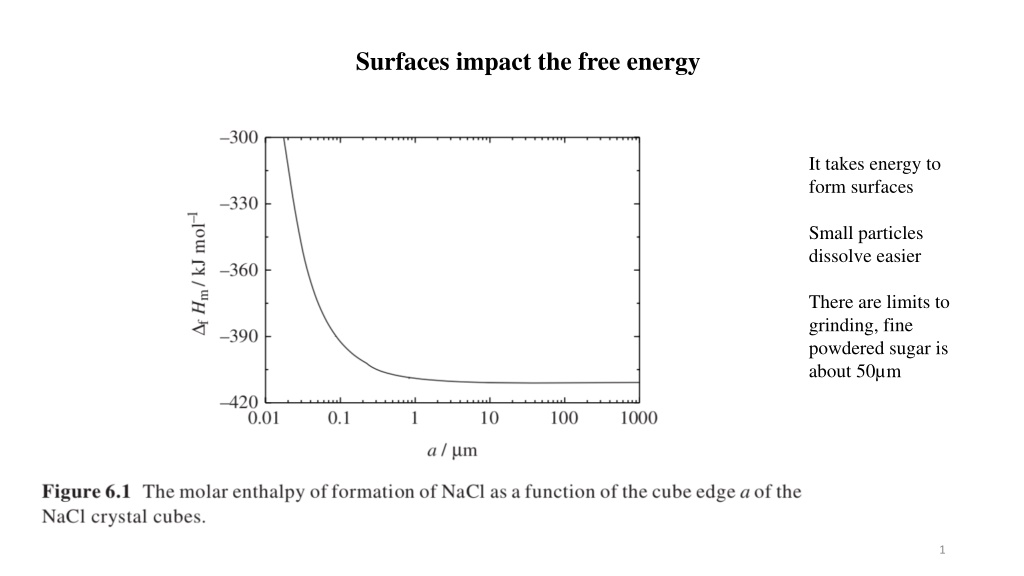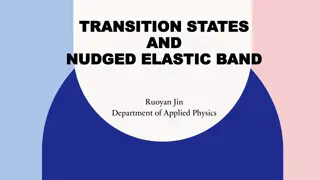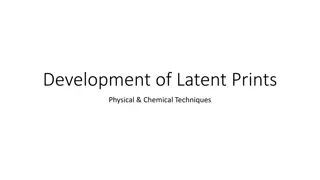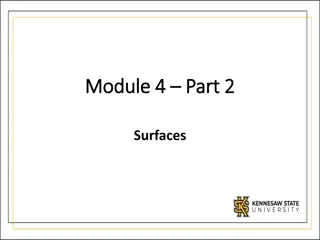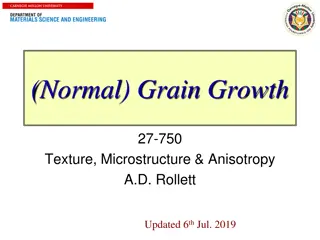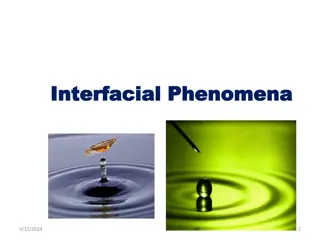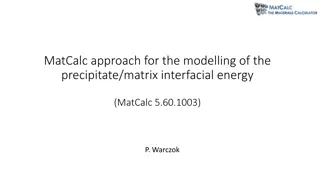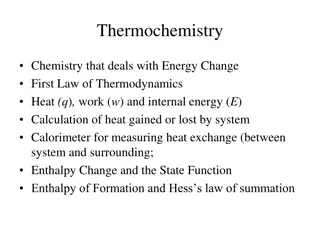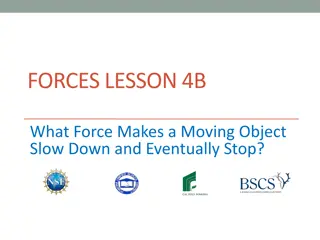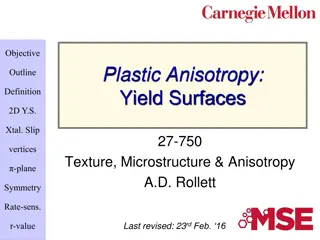Understanding Surfaces and Interfacial Energy in Chemistry
Surfaces play a crucial role in free energy and dissolution processes, impacting surface tension and interfacial energy. Learn about the adsorption of molecules, surface excess properties, and the contributions of surface area and curvature to surface energy. Dive into concepts such as Laplace's equation for curved interfaces and the relationship between internal energy and interfacial width.
Download Presentation

Please find below an Image/Link to download the presentation.
The content on the website is provided AS IS for your information and personal use only. It may not be sold, licensed, or shared on other websites without obtaining consent from the author. Download presentation by click this link. If you encounter any issues during the download, it is possible that the publisher has removed the file from their server.
E N D
Presentation Transcript
Surfaces impact the free energy It takes energy to form surfaces Small particles dissolve easier There are limits to grinding, fine powdered sugar is about 50 m 1
Surfaces impact the free energy DH/r3 = DHbr3/r3 + sr2/r3 = DHb + s/r It takes energy to form surfaces Small particles dissolve easier There are limits to grinding, fine powdered sugar; about 50 m 2
Aggregates versus primary particles 3
Liquid-gas or solid-gas interface is called a surface For surfaces we define a surface tension, s s, energy/area Liquid/liquid or solid/liquid or solid/solid is just called an interface For interfaces we define the interfacial energy, g g, energy/area Gibbs Surface 4
Adsorption (not Absorption) see video Surface Excess Moles The adsorption of i There could be surface excess i or surface depletion of i Gican be positive or negative Adsorption of i Surface Excess Properties 5
What is the change in internal energy by introduction of a surface? -SUV H A -pGT V doesn t change Surface excess Surface Excess 6
Two additional contributions to the surface energy 1) Surface Area and 2) Curvature Energy Terms, cx = 1/rx, cy = 1/ry If the thickness is much smaller than r you can ignore curvature For V/L or V/S Definition of Surface Tension Surface Tension 7
Derive Laplace Equation Curved Interface (Laplace Equation psat ~ s s/r) Force/Area x Distance = Energy/Area Pressure reaches equilibrium a dAs = 0 for flat surface dl b For a sphere A =4p/3 r2 :: dA =8p/3 r dr c = 1/r so dA = 2A/r dr = 2Acdr if dr = dl dA = 2cAdl a dl b Change in internal energy is proportional to the change in interfacial width 8
Laplace Equation For a 100 nm (1e-5 cm) droplet of water in air (72 e-7 J/cm2 or 7.2 Pa-cm) Pressure is 720 MPa (7,200 Atmospheres) 9
For S/S, S/L, L/L Solid interface in a 1-component system -SUV H A -pGT Work to create the interface Interfacial energy, g Surface creation always has an energy penalty. g is always positive Nano-particles are unstable (increase in free energy with a surface) Differences in surface energy for different crystal surfaces leads to fibrous or lamellar crystals 10
Crystal surface energy ~ number of bonds * bond energy Density of bonds decreases with Miller Indices (Each pair share a bond) FCC Nearest Neighbors Number of bonds [111] 6 [110] 12 [100] 8 3 6 4 Liquid droplets minimize surface area for a given volume So, Spheres form At high temperatures crystalline solids also form spheres Because surface energy becomes less important Consider a crystal with constant volume with N facets. Draw a vector from the center of a crystal to a face, hn. 11
Wulff Construction O is area g surface energy Surface excess energy Draw a vector from the center of a crystal to a face. Gibbs-Wulff Theorem states that the length of the vector is proportional to the surface energy hj = lgj Higher energy surfaces grow preferentially (l l is a constant) Minimization to find the lowest free energy hj Oj is proportional to the volume of a facet so for constant volume: And for constant volume: And And So: Diffusion rates and twinning can alter the crystal shape for large crystals 12
Pressure difference for solid crystal facets (Force/length)/length = Force/Area Laplace Equation 13
Strength of bonding impacts surface tension d-block transition metals have strong bonds 14
Strength of bonding impacts surface tension d-block transition metals have strong bonds 15
Strength of bonding impacts surface tension d-block transition metals have strong bonds 16
Empirical relationship for the temperature dependence, entropy at interface is high, n ~ 1.2 for metals. For a liquid with its own vapor Reminiscent of DG = DH(1-T/T*) Liquid/Vapor surface 18
From Hiemenzs Book Force to increase a 2d film area You apply the force to the the side l and the opposite side l so 2l. F ~ 2l or F/(2l) = g 19
Perimeter gamma cosq= mgh w = Force P = Wetted Perimeter t = Thickness l = Plate Length 20
t is the tangent vector along the surface at the point of contact, ts s is a force in the tangent direction Larger angle means smaller displacement t, t ~ 1/sin(q q) This defines the observed angles in a micrograph in terms of the surface tension for the various phases 22
Three phases and three angles Define the phase by the angle Take the a, qline as the vector direction then gaq + gqbcos(q) + gbacos(a) = 0 using the dot product of the vectors For the q, bline as the vector direction then gaqcos(q) + gqb + gabcos(b) = 0 using the dot product of the vectors For the a, bline as the vector direction then gaqcos(a) + gqbcos(b) + gab = 0 using the dot product of the vectors bis a flat rigid surface, b = p gaqcos(q) + gqb + gabcos(b) = 0 gglcos(q) + gls - ggs = 0 Spreading Parameter: S>0 wets; S<0 partially wets For S<0 24
Pressure for equilibrium of a liquid droplet of size r Reversible equilibrium At constant temperature dpl =Vg/Vl dpg Differential Laplace equation Small drops evaporate, large drops grow 27
In the absence of nuclei, the initial bubbles on boiling can be very small These bubbles are unstable due to high pressure so boiling can be prevented leading to a superheated fluid Equilibrium Ideal gas Laplace equation for pressure Smaller bubbles at higher temperatures 28
Solubility and Size, r Consider a particle of size ri in a solution of concentration xi with activity ai Derivative form of the Laplace equation -SUV H A -pGT Dynamic equilibrium For an incompressible solid phase Definition of activity Solubility increases exponentially with reduction in size, r Small particles dissolve to build large particles with lower solubility (xil)r = (xil)r= exp(2gsl/(rRT r)) -To obtain nanoparticles you need to supersaturate to a high concentration (far from equilibrium). -Low surface energy favors nanoparticles. (Such as at high temperatures) -High temperature and high solid density favor nanoparticles. Supersaturation is required for any nucleation 29 One form of the Gibbs-Thompson Equation
Critical Nucleus and Activation Energy for Crystalline Nucleation (Gibbs) Bulk decreases free energy Surface increases free energy (M/r) is molar volume Barrier energy for nucleation at the critical nucleus size beyond which growth is spontaneous 30
Critical Nucleus and Activation Energy for Crystalline Nucleation (Gibbs) 31
Critical Nucleus and Activation Energy for Crystalline Nucleation (Gibbs) Lower T leads to larger DfusGm (Driving force for crystallization) smaller r* and smaller Dl-sG* DfusGm = DfusHm - TDfusSm Deep quench, far from equilibrium leads to nanoparticles 32 One form of the Gibbs-Thompson Equation
Ostwald Ripening PV = m Dissolution/precipitation mechanism for grain growth Consider small and large grains in contact with a solution Grain Growth and Elimination of Pores 33
Formation of a surface nucleus versus a bulk nucleus from n monomers Homogeneous Heterogeneous (Surface Patch) Bulk vs n-mer So, surface excess chemical potential Surface energy from the sides of the patch 35
Barrier is half the height for surface nucleation Stable size is half the size 36
Adamson Physical Chemistry of Surfaces pp. 328 Classical Nucleation Theory 37
condensation 38
Growth rate I is related to collisions Z and Boltzmann probability 39
Three forms of the Gibbs-Thompson Equation Ostwald-Freundlich Equation x = supersaturated mole fraction x = equilibrium mole fraction n1= the molar volume Free energy of formation for an n-mer nanoparticle from a supersaturated solution at T Difference in chemical potential between a monomer in supersaturated conditions and equilibrium with the particle of size r At equilibrium For a sphere 41
Three forms of the Gibbs-Thompson Equation Ostwald-Freundlich Equation Areas of sharp curvature nucleate and grow to fill in. Curvaturek= 1/r Second Form of GT Equation 42
Three forms of the Gibbs-Thompson Equation Third form of GT Equation/ Hoffman-Lauritzen Equation B is a geometric factor from 2 to 6 Crystallize from a melt, so supersaturate by a deep quench Free energy of a crystal formed at supercooled temperature T 43
For fine grain particles at times a high Gibbs free energy polymorph forms a-Al2O3 is the stable form but g-Al2O3 forms for small particles g-Al2O3 has a lower surface energy 135 m2/g ~ 12 nm particles S/V ~ 1/r 44
Adsorption (Adherence to surface, can be chemical or physical) The adsorption Adsorbate Solid or Liquid Adsorbent Molecules in a Liquid or Gas Surface Excess Moles Physical adsorption: Low enthalpy of adsorption; reversible adsorption isotherm Chemical adsorption: Large enthalpy of adsorption; irreversible; chemical change to surface Hysteresis in adsorption isotherm 45
Gibbs Adsorption Equation Internal Energy of System: Surface Excess Internal Energy: -SUV H A -pGT Differential Form with respect to the area: Subtract the total derivative from the differential form yields the Gibbs-Duhem for Surface Excess: Gibbs Adsorption Equation 47
Gibbs Adsorption Equation Gibbs-Duhem Equation: ds/dln(xB))T = -RT[GB (xA/xB) GA) 48
Adsorption, G, depends on the position of the surface Relative Adsorption, doesn t Vais the volume of the a-phase Relative Adsorption Multiply second equation by c ratio then subtract, it doesn t depend on the position of the surface. 49
Relative Adsorption Gibbs Surface Sis located where there is no net adsorption of A 50
